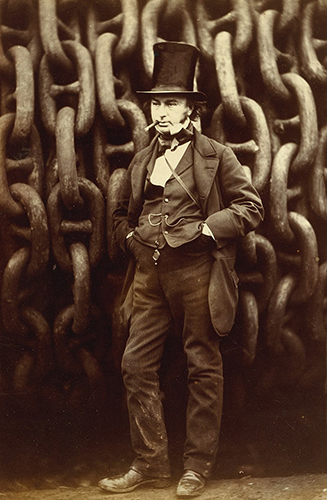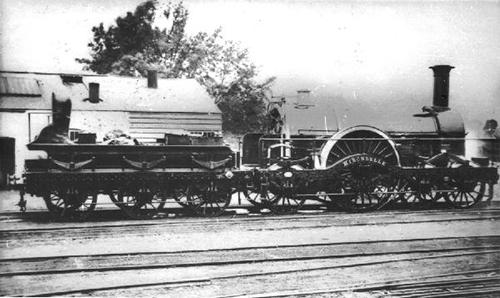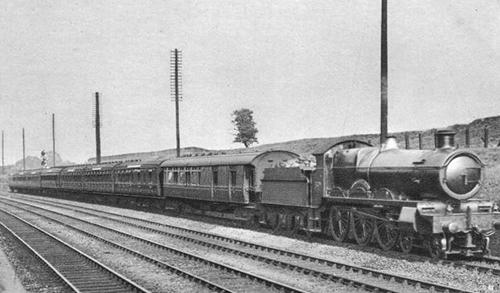

The Gauge Wars were the often-intense conflict between different parties over the width between the rail. Controlling what would become the standard size was paramount to railway companies in Britain in the 19th Century, as this would ensure financial backing and control over the most lucrative routes. Breaks in gauge are disruptive to the movement of traffic.

Probably the most famous image of a railway engineer ever?
Brunel devised his 7'¼" Broad Gauge in 1835, which differed to the 4'8½" Standard Gauge (as it was later known as) used by many other companies around the country. Hostilities began between the Great Western Railway and the London South Western Railway in 1835, when the two lines were competing to run lines from London to Bath and Bristol. The GWR got the Act of Parliament to build the line (which explicitly dictated the line gauge) and the LSWR had to back down.
With the Bristol/Bath line destined to be Broad Gauge, the two companies continued to tussle over the building of new lines to the lucrative tourist and goods destinations in the South West.
The Gauge Wars continued in Gloucester in 1844, when the Broad Gauge Bristol and Gloucester Railway met the Standard Gauge Birmingham and Gloucester Railway. If passengers wished to continue their journey, they would have to change trains – goods would also have to be transloaded from one train to another.
Because of this, the Government appointed a Gauge Commission to sort out the problem caused in Gloucester and the wider problem caused by Brunel and his Broad Gauge. In 1846 they came down on the side of Standard Gauge with the Regulating the Gauge of Railways Act 1846 legislating that all new railways should be built in 4'8½" unless they were in Wales or the South-East of England and connected to the GWR network.

Broad Gauge locomotion – Iron Duke Class 4-2-2 Hirondelle.
Not cowed by events in government, Brunel set about expanding the GWR Broad Gauge network. Lines to Birmingham were built through Oxford and Wolverhampton, and mixed gauge lines were built southwards so that goods trains from the north could reach the south coast without transhipment onto another company’s line.
The industrial area around Birmingham was now well served by several railways, breaking the monopoly of canal-based traffic. To further exploit the industrial expansion, a line was proposed across the Black Country to Wolverhampton. As this was very much GWR territory, Brunel was commissioned to survey for a Broad Gauge line. The Act of Parliament was passed, but there were a few caveats – The line would start joined to the mixed gauge Oxford and Rugby Railway and end adjoining the Grand Junction Railway at Bushbury near Wolverhampton.
The GJR was Standard Gauge, so this new station would have to be a transhipment depot. A complex argument broke out between the GJR and the London and Birmingham Railway over their proposed merger with the Manchester and Birmingham Railway. The GJR threatened to convert to Broad Gauge, as their thought that this deal would bypass their access to London. A proposed spur (which would have to be mixed gauge) between the new Oxford, Worcester and Wolverhampton Railway and the Birmingham and Gloucester Railway also slowed building.
Construction costs sky-rocketed, the railway was rerouted, and there were violent clashes between workmen. In the end, Brunel resigned as chief engineer of the OWWR, although the line was later amalgamated with the GWR.
By 1861, Brunel was having to concede that the battle was lost, and that Standard Gauge had won the Gauge War. Mixed Gauge lines to Paddington allowed through trains to Chester, with Mixed Gauge also added to other routes on the GWR to phase out Broad Gauge, such as between Reading and Basingstoke, Oxford and Wolverhampton. The changeover happened throughout the 1870s, and by the middle of the decade the only Broad Gauge line still in use on services beyond Bristol and the odd branch line.
Despite this, the last Broad Gauge line was built in 1877 to form the St Ives branch. The last Broad Gauge service left London Paddington on its way to Penzance on Friday 20th May 1892. From the week after the services ran on the Standard Gauge line only.
Because of this, the Government appointed a Gauge Commission to sort out the problem caused in Gloucester and the wider problem caused by Brunel and his Broad Gauge. In 1846 they came down on the side of Standard Gauge with the Regulating the Gauge of Railways Act 1846 legislating that all new railways should be built in 4'8½" unless they were in Wales or the South-East of England and connected to the GWR network.

Cornish Riviera train with wider Centenary Coaches.
Although Brunel had lost the Gauge Wars, the GWR still saw a massive period of expansion over the next twenty years – with new routes built and existing routes rationalised. One legacy of Broad Gauge is that due to the wider loading gauge some trains could have wider, more luxurious coaches, such as the boat trains and the Cornish Riviera Express. The Great Western became one of the Big 4 after Grouping in the 1920s, having already amalgamated many of the adjoining railways.